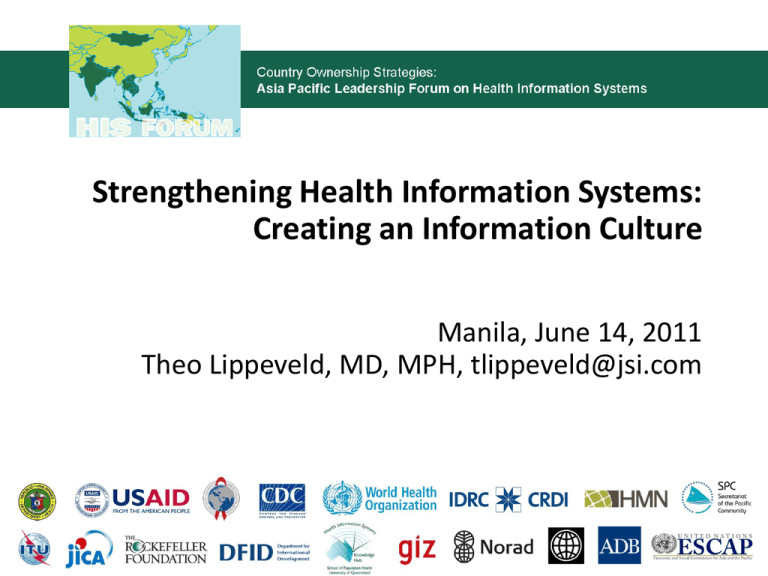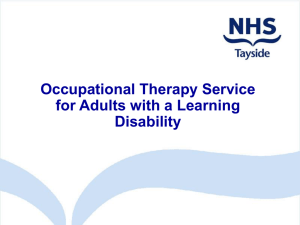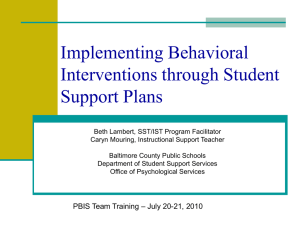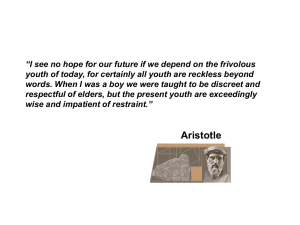Creating an Information Culture - HIS Forum Country Ownership of
advertisement

Strengthening Health Information Systems: Creating an Information Culture Manila, June 14, 2011 Theo Lippeveld, MD, MPH, tlippeveld@jsi.com Objective of this session: let us be more specific Delegates will explore leadership roles in managing health information systems as a national asset … … for improving evidence based decision making in the health system at all levels Overview of this session Introduction on the need for HIS strengthening worldwide Brainstorming on how to improve use of information PRISM framework for HIS strengthening Where does information culture fit in this Questions and answers Global Health: new opportunities and old constraints Recently spectacular increases in money flows (Gates, PEPFAR, the Global Fund, etc.) to address priority infectious diseases (HIV/AIDS, TB, Malaria, etc.) The Millennium Development Goals by 2015: excellent drive for better health outcomes Growing interest in health systems strengthening by the major global health donors But major constraints (old and new) continue to exist What is going wrong? • Lack of leadership and country ownership • Fragmentation of the health system – Disease oriented stove pipe systems • Lack of good models for scaling up evidence based interventions – How to move from pilot to scale? • Health workforce crisis • Weak logistic systems for commodity security • Weak health information systems (HIS) What is wrong with existing HIS? Plethora, irrelevance and poor quality of the data collected Centralization of information management without feedback to district and service delivery levels Fragmentation into “program- oriented” information systems: duplication and waste Poor health information system infrastructure and resources As a result… Poor demand and use of information by users at all levels: policy makers, health managers, as well care providers So, what can be done to improve use of information for decision making? Take 3 minutes to write down possible interventions Is this the HIS final outcome? 8 Some of the lessons learned from HIS reform in recent years • Need for standardized data generation architecture • Need for well defined HIS performance criteria: – Production of relevant and quality information – Continued use of information for DM at all levels • Empirical evidence shows that availability of relevant and quality information does NOT NECESSARILY mean that is it used for decision making Need for better understanding of factors influencing HIS performance PRISM framework: Performance of Routine Information Systems Management PRISM Framework for Understanding Health Information System (HIS) Performance Technical Determinants Inputs HIS assessment, HIS strategies HIS interventions Data generation architecture Information/communication technology Desired Outputs = HIS performance • good quality information • appropriate use of information Improved Health System Performance Improved Health Outcomes 10 Organizational Determinants Behavioral Determinants Information culture, health system structure, roles & responsibilities, resources Knowledge/ skills, attitudes, values, motivation Prism Tools: Measuring HIS performance and its determinants A) HIS Performance Diagnostic Tool Quality of data B) HIS Overview Facility/ Office Checklist Use of information D) HIS Process Assessment Tool C) Organizational & Behavioral Questionnaire PRISM tools allow quantitative HIS performance measurement over time: Example of Pakistan Percent Improvements in Data Accuracy and Use of Information Before and After Pilot test in Pakistan, 2006 80 70 60 50 40 30 20 10 0 Accuracy Use of info Before After OBAT: Competency in Problem Solving R.Dominicana 100.00 90.00 80.00 70.00 60.00 50.00 40.00 30.00 20.00 10.00 0.00 Paraguay Costa Rica Perceived Observed Perú Ecuador Mexico Honduras Based on PRISM assessment: HIS performance improvement interventions Technical interventions Organizational interventions Behavioral interventions Example of technical HIS interventions (the classic approach) Matching information offer with health system demand Defining a set of essential indicators Improving data generation processes Developing user-friendly data collection formats Introducing appropriate ICT for data management Improving integration of data sources Building of a national data warehouse Examples of behavioral interventions • Improve confidence level by asking people to do simple tasks and then add complexity in tasks • Capacity building to improve data analysis, problem solving and advocacy skills of district and facility staff – Organization of in-service training courses – On-the-job training through supportive supervision – Include module in pre-service training programs Examples of organizational interventions • Institutionalize interventions focused on improving use of information Self-assessment Problem solving approach Advocacy Promotion Of Culture Of Information What is a “culture of information” Operational definition (from social sectors): “The capacity of an organization (the health system) to promote among its members the values and beliefs for generation of quality data, and for use of information to accomplish its goals and mission.” • This implies an important role for senior management (policy makers and managers) in the health system • This implies behavioral change (individual and institutional) = long term process Rationale for promoting culture of information • Communication by senior management to health staff that information is considered a key organizational value • Clarify expectations regarding desired behaviors and performance levels for use of information • Improve transparency and accountability within the health system and the health information system • Creating ownership and demand for information, leading to improved use of information for DM • Ultimately in the presence of a culture of information less supervision and less external control is required leading to less costs How to promote culture of information • Role modeling by senior managers on using the information generated for DM • Emphasis on HIS performance during review meetings • Dissemination of success stories of use of info for service improvement and advocacy • Institutionalizing and creating incentives for use of HIS information – Dissemination of HIS district level indicators through media (Uganda): creating competition… – Allocation of resources based on HIS indicators (Brazil) – Use of HIS info as criteria of the annual performance appraisal CONCLUSIONS • A successful HIS not only produces quality information but also makes sure that the information is used to improve health system management functions at all levels and down to the service delivery levels • Senior management needs to promote culture of information for improving performance, accountability, transparency in the health system and to role model use of information Thank You For info on the PRISM framework and tools: see www.rhinonet.org MEASURE Evaluation is a MEASURE project funded by the U.S. Agency for International Development and implemented by the Carolina Population Center at the University of North Carolina at Chapel Hill in partnership with Futures Group International, ICF Macro, John Snow, Inc., Management Sciences for Health, and Tulane University. Views expressed in this presentation do not necessarily reflect the views of USAID or the U.S. Government. MEASURE Evaluation is the USAID Global Health Bureau's primary vehicle for supporting improvements in monitoring and evaluation in population, health and nutrition worldwide.











